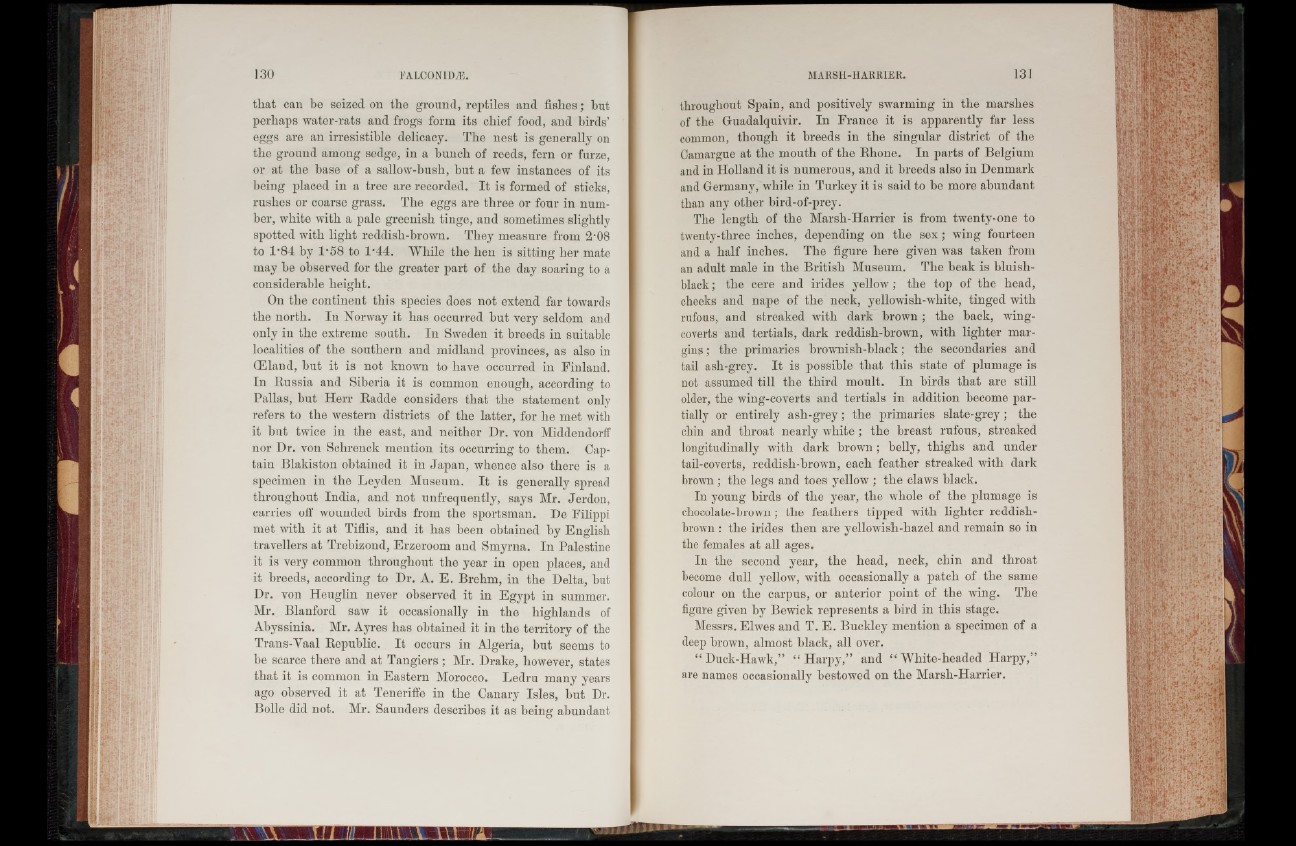
1 3 0 I'AI'CON IDA',.
that can be seized on the ground, reptiles and fishes; but
perhaps water-rats and frogs form its chief food, and birds’
eggs are an irresistible delicacy. The nest is generally on
the ground among sedge, in a bunch of reeds, fern or furze,
or at the base of a sallow-bush, hut a few instances of its
being placed in a tree are recorded. I t is formed of sticks,
rushes or coarse grass. The eggs are three or four in number,
white with a pale greenish tinge, and sometimes slightly
spotted with light reddish-brown. They measure from 2'08
to 1‘84 by l -58 to l -44. While the hen is sitting her mate
may he observed for the greater part of the day soaring to a
considerable height.
On the continent this species does not extend far towards
the north. In Norway it has occurred but very seldom and
only in the extreme south. In Sweden it breeds in suitable
localities of the southern and midland provinces, as also in
(Eland, but it is not known to have occurred in Finland.
In Russia and Siberia it is common enough, according to
Pallas, but Herr Radde considers that the statement only
refers to the western districts of the latter, for he met with
it but twice in the east, and neither Dr. von Middendorff
nor Dr. von Schrenck mention its occurring to them. Captain
Blakiston obtained it in Japan, whence also there is a
specimen in the Leyden Museum. I t is generally spread
throughout India, and not unfrequently, says Mr. Jerdon,
carries off wounded birds from the sportsman. De Filippi
met with it at Tiflis, and it has been obtained by English
travellers at Trebizond, Erzeroom and Smyrna. In Palestine
it is very common throughout the year in open places, and
it breeds, according to Dr. A. E. Brehm, in the Delta, but
Dr. von Heuglin never observed it in Egypt in summer.
Mr. Blauford saw it occasionally in the highlands of
Abyssinia. Mr. Ayres has obtained it in the territory of the
Trans-Yaal Republic. I t occurs in Algeria, but seems to
be scarce there and at Tangiers ; Mr. Drake, however, states
that it is common in Eastern Morocco. Ledru many years
ago observed it at Teneriffe in the Canary Isles, but Dr.
Bolle did not. Mr. Saunders describes it as being abundant
M A R SH -H A llR lE Il. 131
throughout Spain, and positively swarming in the marshes
of the Guadalquivir. In France it is apparently far less
common, though it breeds in the singular district of the
Camargue at the mouth of the Rhone. In parts of Belgium
and in Holland it is numerous, and it breeds also in Denmark
and Germany, while in Turkey it is said to be more abundant
than any other bird-of-prey.
The length of the Marsli-Harrier is from twenty-one to
twenty-three inches, depending on the sex ; wing fourteen
and a half inches. The figure here given was taken from
an adult male in the British Museum. The beak is bluisli-
black ; the cere and irides yellow ; the top of the head,
cheeks and nape of the neck, yellowish-white, tinged with
rufous, and streaked with dark brown; the back, wing-
coverts and tertials, dark reddish-brown, with lighter margins
; the primaries brownish-black; the secondaries and
tail ash-grey. I t is possible that this state of plumage is
not assumed till the third moult. In birds that are still
older, the wing-coverts and tertials in addition become partially
or entirely ash-grey; the primaries slate-grey; the
chin and throat nearly white ; the breast rufous, streaked
longitudinally with dark brown; belly, thighs and under
tail-coverts, reddish-brown, each feather streaked with dark
brown ; the legs and toes yellow ; the claws black.
In young birds of the year, the whole of the plumage is
chocolate-brown; the feathers tipped with lighter reddish-
brown : the irides then are yellowish-hazel and remain so in
the females at all ages.
In the second year, the head, neck, chin and throat
become dull yellow, with occasionally a patch of the same
colour on the carpus, or anterior point of the Aving. The
figure given by Bewick represents a bird in this stage.
Messrs. Elwes and T. E. Buckley mention a specimen of a
deep brown, almost black, all over.
“ Duck-HaAvk,” “ Harpy,” and “ White-headed Harpy,”
are names occasionally bestowed on the Marsli-Harrier.
i ’l l
Ijijii
P i ■if51 l\t
\ ( ’.v r- •» *’ ■ i t ■
#
: *
l i t v C **: r *•
'i
i t
m m .
a I* ■t■ ■ -$